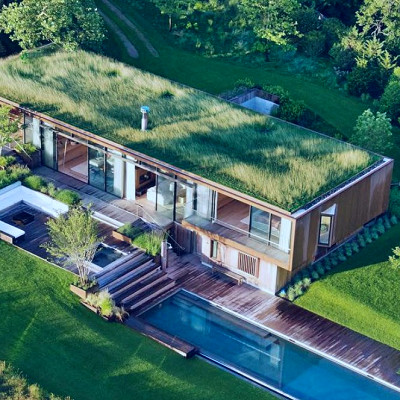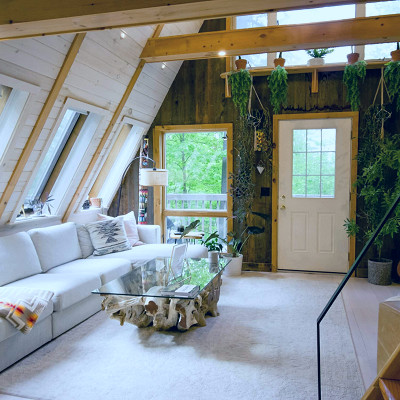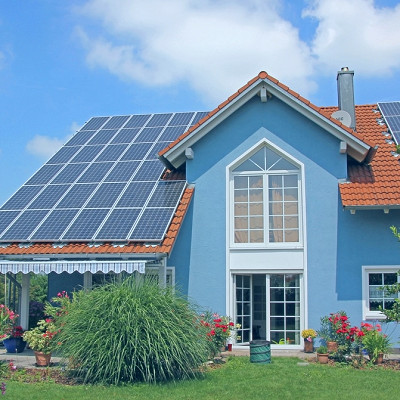 Jarlat Maletych/Shutterstock
Jarlat Maletych/Shutterstock
Features
Introduction to Eco-Friendly Housing
Eco-friendly housing, also known as green building or sustainable construction, refers to the use of resources and processes that are environmentally responsible and resource-efficient throughout a building's life cycle.
Energy Efficiency in Green Housing
Energy-efficient homes use less energy, which reduces the emission of greenhouse gases and saves homeowners money. This can be achieved through installing energy-efficient appliances, using solar panels, and ensuring proper insulation.
Water Conservation Techniques
Eco-friendly homes often incorporate water conservation strategies such as rainwater harvesting systems, greywater systems, and the use of water-efficient appliances.
Sustainable Building Materials
Green building involves the use of sustainable materials like recycled metal, reclaimed wood, and renewable plant materials. These materials reduce the environmental impact associated with the extraction, transportation, and disposal of conventional building materials.
Indoor Environmental Quality
Eco-friendly houses focus on improving indoor environmental quality by reducing indoor pollutants, enhancing natural light, and promoting better air quality.
Land Use Considerations
Building eco-friendly homes involves careful consideration of land use, including site selection, orientation, landscaping, and community infrastructure to minimize environmental impact.
Passive Solar Design
This design technique takes advantage of the sun's energy to heat and cool the building in an eco-friendly way, reducing the need for artificial heating or cooling.
Green Roofing
Green roofs, covered with vegetation, reduce stormwater runoff, improve insulation, and lower urban heat island effects.
Net-Zero Homes
A net-zero home produces as much energy as it consumes on an annual basis, usually through a combination of energy-efficient design and renewable energy sources.
Tiny Houses
The tiny house movement promotes a simpler, more sustainable lifestyle by reducing the physical footprint of a home and the resources needed to maintain it.
LEED Certification
The Leadership in Energy and Environmental Design (LEED) certification is a globally recognized symbol of sustainability achievement in green building.
Energy Star Ratings
Energy Star certified homes meet strict guidelines set by the U.S. Environmental Protection Agency for energy efficiency and greenhouse gas emissions.
Biomimicry in Green Building
Biomimicry involves designing buildings that emulate the strategies found in nature to manage resources and energy efficiently.
Geothermal Heating and Cooling
Geothermal systems use the constant temperature of the earth to heat and cool homes, reducing reliance on fossil fuels.
Low VOC Products
Using low VOC (Volatile Organic Compounds) materials and products in the construction and decoration of homes can significantly improve indoor air quality.
Natural Lighting Strategies
Incorporating large windows, skylights, and light tubes can enhance natural lighting in a home, reducing the need for artificial lighting.
Waste Management in Construction
Green building involves strategies to reduce, reuse, and recycle construction waste, minimizing its environmental impact.
Healthy Home Environment
Eco-friendly homes are not just good for the environment; they also create a healthier living space by reducing allergens and toxins.
Eco-Friendly Landscaping
Native plants, permeable paving, and composting are some of the eco-friendly landscaping strategies that can complement a green home.
The Future of Green Building
With increasing environmental concerns and technological advancements, the future of green building looks promising with potential for more energy-efficient, sustainable, and healthy living environments.
Interesting notes and facts
1. Living the Green Dream: EarthshipsHave you ever heard of Earthships? These unique eco-homes, made from recycled and natural materials, are designed to be self-sufficient. Imagine living off-grid, your home heated and cooled by the earth itself, rainwater meeting all your water needs, and a built-in greenhouse for growing your own food. It may sound too good to be true but thousands of these homes exist around the world.
2. Bamboo: The Super Material
Bamboo is not just for pandas anymore. With a growth rate far surpassing that of conventional trees, bamboo is a sustainable and versatile building material. Resistant to pests and strong enough to withstand earthquakes, bamboo homes are both practical and eco-friendly.
3. Eco Pods: Compact and Sustainable
Eco Pods are the epitome of compact, green living. Manufactured off-site and delivered ready to live in, these small homes are designed with efficiency in mind. They have a tiny carbon footprint and can be powered by renewable energy sources. Ideal for those with a minimalist lifestyle who seek harmony with nature.
4. Green Roofs: Urban Jungle
Green roofs are a fantastic way to combat urban heat islands and increase biodiversity. They insulate buildings, reducing energy consumption, and provide a habitat for local wildlife. Plus, they can be used to grow vegetables and herbs, turning wasted roof space into a productive garden.
5. Cob Houses: Back to Basics
Made from a mixture of clay, sand, and straw, cob homes hark back to a simpler time. These affordable, comfortable homes can be built by hand and are naturally insulated. Cob homes can last hundreds of years and blend seamlessly into the landscape.
6. Passive Houses: Maximum Comfort, Minimum Energy
Passive houses are built with one main goal: to reduce the need for artificial heating and cooling. With their high-quality insulation and airtight construction, passive houses can save up to 90% in heating and cooling costs.
7. Shipping Container Homes: Repurposing with Style
Who knew that shipping containers could be transformed into stylish and sustainable homes? These structures are strong, plentiful, and perfect for modular design. Container homes can also be built quickly, reducing construction waste and costs.
8. Tiny Houses: Less is More
The tiny house movement is all about downsizing and living more simply. These compact homes are often built on wheels for mobility and are meticulously designed to make use of every inch. Tiny houses can be powered by solar panels, making them a great option for eco-minded individuals.
9. Straw Bale Houses: A Breath of Fresh Air
Straw bale houses are not only charming but also energy-efficient and breathable. The thick straw walls provide excellent insulation, keeping the house cool in the summer and warm in the winter. And the best part? They're built using a renewable resource.
10. Tree Houses: Living Among the Canopy
Tree houses aren't just for kids! These unique homes can be built with minimal impact on the environment, preserving the natural landscape. Not to mention, there's something magical about living among the treetops, closer to nature.
Vocabulary
- Eco-friendly Housing – A type of housing that minimizes harm to the environment through its design, construction, operation, and ultimate disposal.
- Natural Medicine – The practice of preventing or treating diseases using natural substances or processes.
- Organic Food – Food that is produced without the use of synthetic chemicals or genetically engineered components.
- Veganism – A lifestyle choice to abstain from the use of animal products, particularly in diet.
- Fitness – The condition of being physically fit and healthy.
- Mental Health – A person's condition with regard to their psychological and emotional well-being.
- Holistic Medicine – A form of healing that considers the whole person -- body, mind, spirit, and emotions -- in the quest for optimal health and wellness.
- Clean Eating – The practice of eating whole foods in their most natural state, and avoiding processed foods.
- Medicinal Herbs – Plants that have a medicinal value and can be used to treat various ailments.
- Nutritional Supplements – Substances you might use to add nutrients to your diet or to lower your risk of health problems.
- Yoga – A Hindu spiritual and ascetic discipline, a part of which, including breath control, simple meditation, and the adoption of specific bodily postures.
- Meditation – A practice where an individual uses a technique – such as mindfulness, or focusing the mind on a particular object, thought, or activity – to train attention and awareness, and achieve a mentally clear and emotionally calm and stable state.
- Detox – A process or period of time in which one abstains from or rids the body of toxic or unhealthy substances.
- Vegan Skincare – Skincare products that do not contain any animal products or by-products.
- Organic Farming – A method of crop and livestock production that involves much more than choosing not to use pesticides, fertilizers, genetically modified organisms, antibiotics and growth hormones.
- Alternative Medicine – Any of a range of medical therapies that are not regarded as orthodox by the medical profession.
- Homeopathy – A system of natural health care that has been in worldwide use for over 200 years.
- Acupuncture – A form of alternative medicine and a key component of traditional Chinese medicine in which thin needles are inserted into the body.
- Aromatherapy – The use of aromatic plant extracts and essential oils for healing and cosmetic purposes.
- Chiropractic – A system of complementary medicine based on the diagnosis and manipulative treatment of misalignments of the joints.
- Probiotics – Live bacteria and yeasts that are good for your health, especially your digestive system.
- Paleo Diet – A dietary plan based on foods similar to what might have been eaten during the Paleolithic era.
- Gluten-free Diet – A diet that strictly excludes gluten, which is a mixture of proteins found in wheat and related grains.
- Ketogenic Diet – A low carb, high fat diet that offers many health benefits.
- HIIT – High-Intensity Interval Training, a type of workout that involves short bursts of high-intensity exercises followed by short periods of rest or low-intensity exercises.
- Pilates – A system of exercises using special apparatus, designed to improve physical strength, flexibility, and posture, and enhance mental awareness.
- Naturopathy – A system of treatment that relies on natural remedies, such as sunlight and air, and on the body's own healing powers.
- Reiki – A healing technique based on the principle that the therapist can channel energy into the patient by means of touch, to activate the natural healing processes of the patient's body and restore physical and emotional well-being.
- Ayurveda – A system of medicine with historical roots in the Indian subcontinent.
- Vegan Diet – A diet that contains only plants (such as vegetables, grains, nuts and fruits) and foods made from plants.
- Superfoods – A nutrient-rich food considered to be especially beneficial for health and well-being.
- Raw Food Diet – A diet consisting mainly or entirely of food that is uncooked and unprocessed.
- Mindfulness – The quality or state of being conscious or aware of something.
- Reflexology – A system of massage used to relieve tension and treat illness, based on the theory that there are reflex points on the feet, hands, and head linked to every part of the body.
- Qi Gong – A Chinese system of physical exercises and breathing control related to tai chi.
- Tai Chi – An ancient Chinese tradition that, today, is practiced as a graceful form of exercise.
- Plant-based diet – A diet based on foods derived from plants, including vegetables, grains, nuts, seeds, legumes and fruits, but with few or no animal products.
- GMO Free – Products or foods that do not contain any genetically modified organisms.
- Green Living – A lifestyle that



